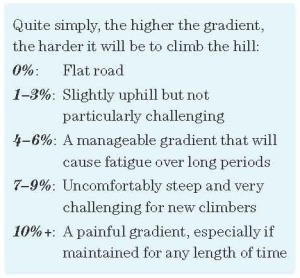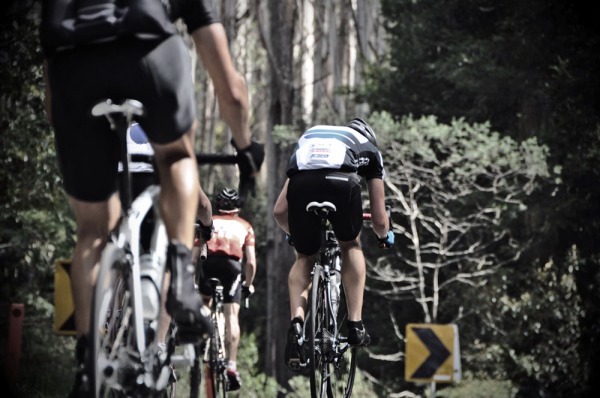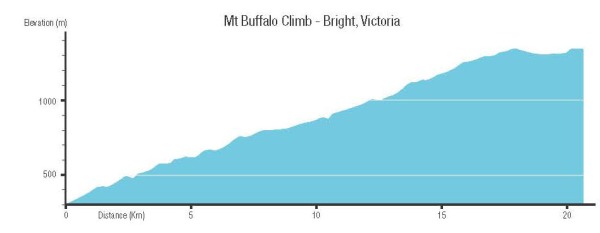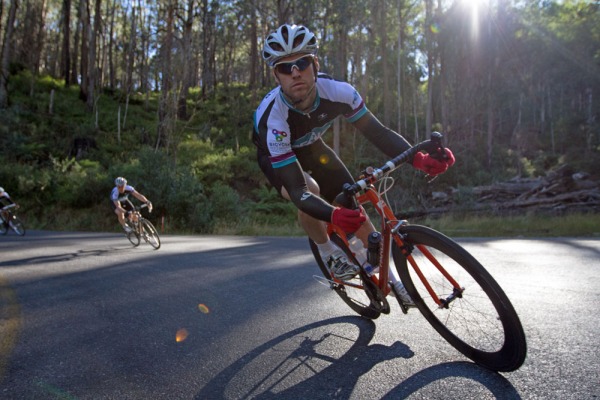When you find a comfortable rhythm on a great climb in terrific weather, you’ll know just how enjoyable climbing can be. The Climbing Cyclist, Matt de Neef, shares his passion.

You don’t forget your first mountain. Mine was Mt Buffalo more than a decade ago, conquered as a naive teenager on a family camping trip to Victoria’s high country.
One afternoon I proudly declared to my dad: “I’m going to ride up Mt Buffalo.” He paused briefly and gave me his best “you’re crazy” eyes. He had every reason to be sceptical: the longest climb I’d done to that point was 2km long. And here I was, announcing without a shred of doubt that I’d be able to conquer a 20km+ long mountain climb, on a rickety old mountain bike, without a scrap of training.
But he let me try. Not only that, he followed me the whole way up in the car to make sure I was OK, handing me lollies to keep my energy reserves up, filling my water bottles when they ran dry.
It took me nearly two and a half hours, plenty of breaks and more than a few queries of “Are you sure you want to keep going?”s from my dad, but I eventually reached the Mt Buffalo Chalet and belted out a “Yeeeeeee-haaaaaa!!!” that sent birds flying from the trees.
It was the greatest feeling of accomplishment I’d ever experienced. I was on top of the world – metaphorically and, if the amazing views were anything to go by, literally as well. I felt invincible. Utterly exhausted, but invincible.
It was the greatest feeling of accomplishment I’d ever experienced. I was on top of the world – metaphorically and, if the amazing views were anything to go by, literally as well. I felt invincible.
In many ways, that’s where my love affair with cycling uphill began. Now, a decade later I’ve ticked virtually all of Victoria’s major mountains off my “to-climb” list.
You might be reading this and thinking to yourself, “How could riding up a mountain ever be fun?” Picture this: you’ve been climbing for nearly an hour and the views have been improving ever since the road started following the ridgeline. You’re starting to get tired but you know that you have the strength (physical and mental) to reach the top. Finally, after nearly two hours, you reach the summit. You prop your bike against a nearby tree and drink in the amazing views: the muted greens of the fields below, the faded blues of the distant mountains and the brilliant cobalt of the sky you’re standing in. “I got here under my own steam”, you think to yourself. “I’ve earned this.”
Of course, amazing views are only part of the reward – there’s also the descent to look forward to.
After a well-earned rest and something to eat and drink, you get back on the bike and start rolling down the hill. For the next 40 minutes you fly down the mountain, enjoying the beautiful, winding road, the tremendous views and the fact you don’t even need to pedal.
A primer for non-climbers
Of course, if you haven’t done much climbing, taking on an epic mountain like Mt Buffalo can be an intimidating prospect. But with the right training and a bit of homework, the daunting can quickly become manageable.
Selecting a climb
 First you’ll need to do a bit of research and identify your target climb. Thankfully there are a number of great online resources to help you with this task.
First you’ll need to do a bit of research and identify your target climb. Thankfully there are a number of great online resources to help you with this task.
Strava is excellent for finding out where a climb starts and finishes and how steep it is. Tools like RideWithGPS and MapMyRide are great for generating profiles so you know what the mountain will throw at you. And I’d like to think that my own site, The Climbing Cyclist (www.theclimbingcyclist.com), has some valuable information about many of the great cycling climbs around Victoria.
Equally as important as the length of the climb is how steep it is. This is known as the gradient and is normally expressed as a percentage.
We can approximate the average gradient of a climb by taking the elevation gain (in metres), dividing it by the distance ridden (in metres) and then multiplying by 100 (to get a percentage).
For example, Mt Donna Buang in Victoria’s Yarra Valley rises 1069m in 16.8km. By calculating (1069/16,800) x 100 we arrive at an average gradient of 6.4%.
But average gradient can only tell us so much. Why? Because it’s a very rare climb that has the same gradient from bottom to top. Virtually every climb will have a few sections that are steeper than the average gradient, some flatter sections and even some downhill sections. Be aware that apparently flat sections are often still slightly uphill and don’t offer complete relief from climbing. These are called ‘false-flats’.
For an example of a deceptive average gradient, take Victorian Alp Mt Hotham at roughly 4.5 per cent. That number doesn’t tell you about the three nasty sections where the gradient reaches 10% or above. It also doesn’t tell you that Mt Hotham has a long false-flat section and two steep downhill sections.
So doing a bit of research about your target climb can give you a good idea of what to expect. Getting through a nasty, steep pinch is a lot easier if you know it’s just 500m long. Similarly, a long, consistent section of climbing can feel a lot more manageable if you know there’s a flatter stretch waiting for you.
Training
With your research done, it’s time to get training. Start on a short, gentle climb and concentrate on finding a rhythm. Once you can get through that climb without too much trouble, try a slightly longer climb. And when that feels comfortable, try stringing a few climbs back-to-back.
If your target climb has some steep sections, go and get a feel for those higher gradients in training. Seek out roads with short, steep rises (Strava is very useful for this) and, again, concentrate on trying to find a rhythm.
If you feel like you’re grinding away at a low cadence (pedal revolutions per minute) while climbing, it might be worth investing in a compact crankset and/or a larger cassette. A standard road bike crankset will normally have 39 teeth in the small chainring. Installing a 34-tooth compact chainring will allow you to spin up the climbs, rather than having to grind. Combine that with a 28-tooth sprocket at the back and you’ll have the gears to get you up most inclines without too much trouble.
Preparation
So it’s the day before you take on your target climb and you’re getting packed and ready to go. What do you take?
The most obvious answer (besides your bike and helmet) is food and drink. Take two water bottles with you – or one with water and one with sports drink if you prefer – and make sure you have enough food to see you through the ride.
To ensure your energy levels don’t drop suddenly (known as “bonking”) or you don’t get dehydrated, get into the habit of eating before you’re hungry and drinking before you’re thirsty.
It’s also important to be aware that mountain weather can change dramatically in just minutes. Even if the weather forecast is looking clear, it’s a good idea to take a water- and windproof jacket with you.
You mightn’t feel like you need it when you’re climbing, but when you get to the top and start descending, you’ll be grateful for the extra layer. And if it starts to rain, you’ll be even more grateful.
It’s also important to get into the habit of checking your brakes before you ride, especially before taking on a climb. You really don’t want to get to the top of the mountain and realise your brake pads are worn right down and largely unusable.
On the day
So you’ve done the training, researched the climb and organised the appropriate gearing and equipment. All that’s left to do is climb the mountain! Easy, right?
Even for stronger climbers, it can be very daunting to look up and realise there are many kilometres of climbing ahead. To make the challenge less daunting psychologically, break the climb into smaller, more-manageable chunks.
For example, Mt Hotham is a 30km-long climb, but it can be broken into three distinct sections: an 11km opening section, a 9km false-flat and then a tough and undulating final 10km to the top. Don’t look at Mt Hotham as one big climb: look at it as three shorter climbs. Focus on getting through the first section, and when you do, give yourself a pat on the back. Then focus on the second section and subsequently tick that off. The last section has the ultimate goal of the summit to lure you on upwards. Easy.
Save any excess energy for the end of the climb – you don’t want to go out too hard and find you’ve got nothing in the tank for the rest of the climb.
It’s also important not to start the climb too fast. Save any excess energy for the end of the climb – you don’t want to go out too hard and find you’ve got nothing in the tank for the rest of the climb. Instead, concentrate on finding a comfortable rhythm as soon as you can.
While it might feel more comfortable to grind away in a bigger gear at a lower cadence, it’s a good idea to spend most of the climb spinning at a higher cadence, as this places less strain on the knees and ensures your legs don’t fatigued any quicker than they need to.
If your legs start to get sore you can always get out of the saddle to mix things up a bit, but spend most of the climb seated if you can. It might feel like you’re going faster while standing, but you’ll be more efficient when you’re sitting down.
But most importantly, try to enjoy yourself! It might sound strange, but the moment you find a comfortable rhythm on a great climb in terrific weather, you’ll get a feel for just how enjoyable climbing can be.
Head for the hills with like-minded riders
As satisfying as it is to ride to the top of a mountain on your own, there’s something wonderful about conquering a climb with other like-minded cyclists. But if you’re new to cycling and/or attempting your first climb, it can be hard to find like-minded individuals of a similar ability and mindset.
With this in mind, myself and Andy van Bergen (from the Hells 500 cycling collective) have organised a series of rides to help cyclists enjoy the challenge of mountain climbing in a safe, group environment. Our 7 Peaks Domestique Series take on the biggest (and most satisfying!) climbs in Victoria with the benefits of on-road support and the company of a great bunch of guys and girls. Most importantly, we make sure that no-one gets left behind (yes, even if it’s your first mountain climb and you’re really slow!).

One for all, all for the summit.
There are also a number of challenge rides around Australia that feature significant climbing – basically, where there are hills there’ll be cyclists who want to climb them. Doing it as part of an event provides support and a big dose of the social aspect of cycling. As a quick list, try Perth’s Dams Challenge, Adelaide’s Mt Lofty Challenge, Hobart’s Mt Wellington Challenge, Brisbane’s Coot-tha Challenge and Canberra’s Fitz’s Challenge.
And if you’re looking for an even greater challenge, there are long, challenging cycling events that are all about climbing. One of these is Bicycle Network Victoria’s 3 Peaks Challenge, held in March, which combines three very tough alpine climbs in a 235km-long route that tests even the strongest cyclists.
Sure, riding uphill for fun might seem like a strange concept, but with the right preparation and the right mindset it can be one of the most rewarding aspects of cycling. I’ve certainly got the climbing bug and I know I’m not the only one. With any luck, I’ll see you in the mountains soon.
Join Hells 500 and The Climbing Cyclist for a series of free rides to fill your 7 Peaks Alpine Ascent Challenge passport.
Ride On content is editorially independent, but is supported financially by members of Bicycle Network. If you enjoy our articles and want to support the future publication of high-quality content, please consider helping out by becoming a member.



“Joy” doesn’t even cover it for me. Mt Buffalo was my first serious climb too, and the experience was nothing less than spiritual. Great post.
Thanks Dylan. 🙂
Although this article is about road biking I have to point out that climbing on a mountain bike can bring a similar kind of joy, but one that adds the technicality and concentration of uneven and uncertain terrain. I don’t know why people are always so bummed about the ups! Good post. 🙂
Great article, Matt. Mt Buffalo was also my first climb. The road was closed half-way up because of a boulder slip. I walked around it and had the second half of the climb, free of cars. That day I was the only person on Buffalo. Glorious. I got addicted and last year climbed quite a few French Alps and wrote about it in my book, ‘baguettes and bicycles’, if you’ll pardon the shameless plug.
http://www.amazon.com/baguettes-and-bicycles-ebook/dp/B00ADTILCW
Hi Steven, a couple month ago I bought a book call ‘A Walk in the Wood’ and ‘Down Under’ by Bill Bryson, who travels by two feet. Since I am crazy about cycling, and hope one day to ride a few of the Alps, I am so looking forward to buy and read this one of yours – travel by two wheels. But I find this only comes with Kindle Edition (from amazon.com), I am that sort of old fashion reader who likes read as well as feel the book. Before I search further, can you tell me there is any book version rather than Kindle for this one?
Heidi
Hi Heidi,
thanks for your interest. All of my other books are available in paperback, but alas, this one is only available as an eBook. However, I add you don’t need a kindle to read it. You can download a free kindle app to your computer and read it from there. Still not as good as a ‘real’ book, I know! But, the plus side is the price is much cheaper. Love the Bill Bryson books, by the way.
Thanks for the reply, Steven. The introduction part of the book has already made me have a few chuckles, it brings back the memory of my first ride. I will have to borrow my kids ipad, see whether I can download to there to read the whole. Type your name in my local library website, I has found and borrowed the two books of yours for my 8 yrs twins – Do-Wrong Ron and Naked Buniy Dancing, with some risk of wrong doing like the part of ‘School Rules’, but hell, I like it.
What are the dates of all these rides
Hi Daniel,
If you question about the 7 peaks rides with Hells500, here is the website – http://theclimbingcyclist.com/the-7-peaks-domestique-series, which gives you all the detail of each ride. The next one of 7 peaks is Mt Baw Baw on 24th Feb, and if you are so into the climb, there is exciting one this Sunday call ‘Dirty Dozon 2013’ – http://theclimbingcyclist.com/dd13.
Cheers
I recently did Buffalo on the Audax Alpine Classic. The ride up was great but I found the descent challenging; there are a number of good articles on climbing strategies but very few on coping with long decents with daunting drops off the side of the road and coming to grips with that is as important as the climbing aspect.